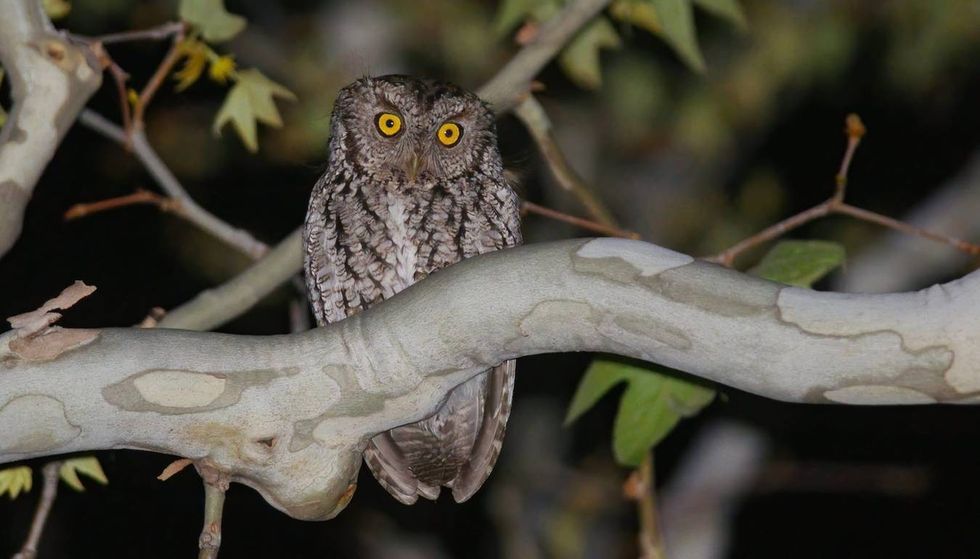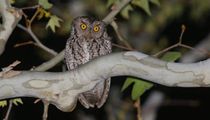There are a total of 25 species of screech owls namely, western screech owl, eastern screech owl, whiskered screech owl, tropical screech owl, middle American screech owl, black-caped screech owl, Puerto Rican screech owl, and the Pacific screech owl, among others. These species of owls are specifically called screech owls because, you guessed it, they screech.
This article aims at looking at some fun and interesting facts about the whiskered screech owl, also known as the spotted screech owl.
Screech owl's habitats range from North America to Nicaragua, passing through South Dakota, New Mexico, and Central America. Screech owls are also common in Minnesota.
They are also seen in parts of Arizona. In some parts of the country, their population is declining due to changes in habitat. Owls were considered to be a symbol of wisdom and intelligence in the Bible.
But in Native American legends, owls are considered a symbol of death. Hearing owls is considered to be a bad omen. The Greek goddess Athena was considered to be the symbol of the owl representing wisdom.
Whatever associations were made to owls in the past, each owl species is unique in its own way. If you liked this article don't forget to check out the tawny owl and the northern spotted owl.
Whiskered Screech Owl Interesting Facts
What type of animal is a whiskered screech owl?
The whiskered screech owl, Megascops trichopsis, is a type of owl animal and belongs to the Animalia kingdom.
What class of animal does a whiskered screech owl belong to?
The whiskered screech owl is a type of bird and belongs to the Aves class of species and Strigidae family.
How many whiskered screech owls are there in the world?
The exact number of whiskered screech owls, Megascops trichopsis, in the world is not known. There exist 25 species of screech owls and all are known by their ability to screech but differ in appearance and characteristics.
Where does a whiskered screech owl live?
Whiskered screech owls are nocturnal in habits and shelters during the day close to the tree trunk. They are seldom seen out in the open and are identified by their voice. These birds are also spotted on sycamore trees. They are distributed evenly range across southeast Arizona, Mexico, Central America, and North America
What is a whiskered screech owl's habitat?
Their habitat is primarily in higher elevations in trees i.e. in mountain forests oak woodlands, coniferous trees.
They prefer staying at higher elevations and are distributed evenly across the range of southeast Arizona, Mexico, Central America, and North America. They reside in areas where they can easily find possible prey for which they hunt usually at night but they are also seen hunting during daytime.
Who do whiskered screech owl live with?
Owls are largely solitary beings and come together only during mating season. They are monogamous beings in general and the pairs stay together for the whole year. They are territorial beings and are known to be defensive if their territory is approached. These species coexist with other wild species.
How long does a whiskered screech owl live?
The average life expectancy for a screech owl is 14 years. As per records, a western screech pair lived to be 19 years. The longest lifespan recorded in the wild is at least 13 years. The whiskered screech owl is often confused with the western screech owl because of its similar appearance.
How do they reproduce?
Males and females are monogamous and remain together for at least one mating season. Breeding usually occurs in April and May.
Their breeding habitat is mostly dense coniferous or oak woodlands and coffee plantations. Their nest is in a cavity in a tree, such as oak or sycamore, mostly abandoned, or in a woodpecker hole, and lays up to four white eggs, up to seven meters from the ground.
Both parents help to rear the young. Males defend the breeding territory by singing at night.
After the young have hatched the female shares the hunting. The females remain with the young until they are about one or two weeks old and bring food for the young to feed on and develop.
Their eggs are prey to snakes and other predators hence parents need to stay alert at all times. Once they grow, the young ones leave the nest and lead solitary lives until they reach sexual maturity and the cycle is repeated again.
What is their conservation status?
The whiskered screech owl is a small screech owl and is considered as of Least Concern by the International Union For Conservation Of Nature (IUCN).
Whiskered Screech Owl Fun Facts
What do whiskered screech owls look like?

The whiskered screech owl is a small owl with dark plumage and distinct ear tufts. They have a round head with ear tufts, yellow eyes, and a yellowish bill.
They are nocturnal and shelter during the day close to the tree trunk. They are feathered to the base of the bristled greyish brown toes. They have streaks on underparts and orangish-yellow eyes.
These birds look similar to the western screech owls but have a heavier barring on the breast and are slightly smaller in size. Both the western screech owl and the whiskered screech-owl are confused with one another.
How cute are they?
They are extremely cute to look at however they can be dangerous if approached closely. It's rare to spot an owl out in the open, despite their cultural symbolic meanings and associations, owls are fascinating and unique creatures.
How do they communicate?
Their communication is primarily via hoots and their unique spotted screech. They have regularly spaced hoots, like 'bububububububub', mostly with the emphasis falling on the third note. The female's voice is slightly higher in pitch than the male's. They also employ other sounds like morse code, 'toot-toot, toot, toot,toot-toot, toot.'
How big is a whiskered screech owl?
Whiskered screech owls are 6.4i-7.48 in (16.5-19cm) in length which is five times bigger than the smallest species of owl, the elf owl, which is 4.7-5.5 in (12cm -14cm) in length.
How fast can a whiskered screech owl fly?
The Whiskered screech owl's flight is mothlike and rapid. They are capable of flying great distances and have sharp eyesight to search for prey both during the day and night.
How much does a whiskered screech owl weigh?
Whiskered screech owls weigh 0.154-0.26lbs which is 70-121g. The heaviest owl species is the Blakiston's fish owl and is similar in body size to that of a small child.
What are their male and female names of the species?
Male owls can be referred to as cocks and females as hen's but in most instances, they are plainly addressed as owls.
What would you call a baby whiskered screech owl?
Baby whiskered screech owls are referred to as owlets. Owlets are extremely cute to look at however they are seldom seen in the open unless they are grown up and are solitary beings living independently.
What do they eat?
They are known to consume mostly large insects and anthropods as food but is it also well known to consume prey twice its size including small mammals, cottontail rabbits, bats, large insects, spiders, lizards, earthworms, beetles, and moths, among others. They look for possible prey in compost piles and even on rainy roads.
Are they dangerous?
They are not dangerous unless harmed intentionally in which case they usually flap their wings and great speeds and try to fly away instantly. If a predator is larger screech owls will make themselves look skinny to avoid being eaten and camouflage themselves to look similar to the branch of the tree. They don't attack humans unless provoked.
Would they make a good pet?
These owls are innately wild beings hence they are not adopted as pets and best thrive in their natural environment. They nest in a woodpecker hole and the young owlets leave their nest when they are independent. It's not safe to touch a wild owl as well since they could be carriers of disease or infection of some kind.
Did you know...
The owl's eyes are extremely complex and they have three eyelids. One to sleep, a second one to blink, and the last one to keep the eye clean and healthy. Tawny owls have the sharpest eyesight of all owl species.
There are multiple kinds of owls showcased in the Harry Potter series of novels as well as in the films. All students in the Hogwarts School of Witchcraft and Wizardry had to have their own pets like owls, cats, toads among others.
Owls were also seen dropping mail and packages throughout the series. There were different species of owls used throughout the series.
What time of year do screech owls nest?
Breeding occurs usually in the months of April and May. Their breeding habitat is mostly dense coniferous or oak woodlands and coffee plantations. Their nest site is in a cavity in the tree such as oak, or sycamore and lays three or four white eggs.
Do screech owls eat snakes?
They can eat snakes but they avoid preying on poisonous species to avoid getting attacked in return. They feed on nonvenomous snakes like rat snakes, common garters, and even eastern ribbons.
Feeding on snakes is not a regular event, instead, they search for other insects and anthropods or animals and feed on snakes if they can't find any alternative. If you too wish to see owls you could visit a facility or zoo where they have specific species of owls for you to look at.
Here at Kidadl, we have carefully created lots of interesting family-friendly animal facts for everyone to discover! Learn more about some other birds including the snow goose and the barn owl.
You can even occupy yourself at home by drawing one of our screech owl coloring pages.










